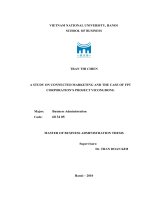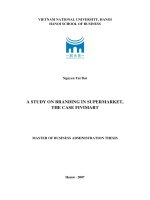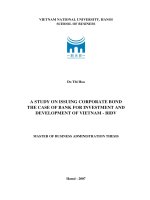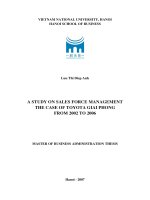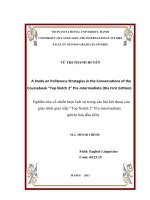A study on sales force management the case of Toyota Giai Phong from 2002 to 2006
Bạn đang xem bản rút gọn của tài liệu. Xem và tải ngay bản đầy đủ của tài liệu tại đây (1.26 MB, 80 trang )
vietnam national university, HANOI
hanoi school of business
Luu Thi Diep Anh
A STUDY ON SALES FORCE MANAGEMENT
THE CASE OF TOYOTA GIAI PHONG
FROM 2002 TO 2006
Master of business administration thesis
Hanoi - 2007
vietnam national university, HANOI
hanoi school of business
Luu Thi Diep Anh
A STUDY ON SALES FORCE MANAGEMENT
THE CASE OF TOYOTA GIAI PHONG
FROM 2002 TO 2006
Major: Business Administration
Code: 60 34 05
Master of business administration thesis
Supervisors:
1. Dr. Vu Huy Thong
2. dr. nguyen viet anh
Hanoi – 2007
ii
TABLE OF CONTENT
ACKNOWLEDGEMENTS i
TABLE OF CONTENT ii
LIST OF FIGURES v
LIST OF TABLES vi
LIST OF CHATS vii
INTRODUCTION 1
CHAPTER 1: SALES FORCE MANAGEMENT 5
1.1. DEFINITION AND THE ROLE OF SALES FORCE
MANAGEMENT 5
1.2. FORMULATION OF A STRATEGIC PROGRAM 6
1.2.1. Sets goals and objectives 6
1.2.2. Demand estimation 6
1.2.3. Determines sales force size and structure 8
1.2.4. Sales territories 11
1.2.5. Quotas setting 13
1.3. IMPLEMENTATION OF THE SALES PROGRAM 14
1.3.1. Sales force recruitment and selection 14
1.3.2. Sales training 15
1.3.3. Sales Motivating 18
iii
1.3.4. Designing compensation and incentive programs 19
1.4. MEASURING SALES FORCE 22
1.4.1. Measuring Sales Force Productivity Drivers 23
1.4.2. Measuring People and Culture 24
1.4.3. Measuring Activity 25
1.4.4. Measuring Customer Results 26
1.4.5. Measuring Company Results 27
CHAPTER 2: ANALYSIS OF SALES FORCE MANAGEMENT AT
TOYOTA GIAI PHONG 28
2.1. INTRODUCTION OF TOYOTA GIAI PHONG 28
2.1.1. TGP history and development 28
2.1.2. Toyota Giai Phong’s organization structure 29
2.1.3. Toyota Giai Phong’s financial competency and facilities 32
2.1.4. TGP’s business performance from 2002 to 2006 34
2.2. THE SALES FORCE MANAGEMENT AT TGP 35
2.2.1. TGP’s sales model 35
2.2.2. Implementation of sales force management at TGP 37
2.3. MEASURING SALES FORCE PRODUCTIVTIES 43
2.3.1. Sales results 44
2.3.2. Customer results 46
iv
2.3.4. Company results 52
CHAPTER 3: SOLUTIONS FOR IMPROVEMENT OF SALES FORCE
MANAGEMENT AT TOYOTA GIAI PHONG 55
3.1. THE VIETNAM AUTOMOTIVE TREND 55
3.1.1 The Vietnam’s automotive market trend 55
3.1.2 The Vietnam automotive consumer’s trend 56
3.2. RECOMMENDED A NEW MODEL FOR TGP 56
3.2.1. Demand estimation 56
3.2.2. Sales force structure 57
3.3. IMPROVING QUALITY OF RECRUITMENT AND TRAINING 57
3.4. DEVELOPING CUSTOMER SATISFACTION PROGRAM 57
3.5. APPLY CRM 59
3.5.1 The core of CRM: 59
3.5.2 Benefits of CRM 60
CONCLUSION 62
REFERENCES 63
APPENDICES 64
v
LIST OF FIGURES
Figure 1.1 Functional Sales Organization…………………………….…….9
Figure 1.2 Geographical Sales Organization……………………… …….10
Figure 1.3 Sales Organization with Product-Specialized Sales Force…… 10
Figure 1.4 Sales Organization Specialized by Type of Customers….… 11
Figure 2.1 Organization Structure of Toyota Giai Phong…………… ….31
Figure 2.2 Sales force structure at Toyota Giai Phong ………………….36
Figure 3.1 TGP’s sales organization specialize by type of customers … 57
vi
LIST OF TABLES
Table 2.1 Human Resource of TGP…………… ………… 33
Table 2.2 TGP’s performance for 5 years……………………….………34
Table 2.3 TGP’s commission table……………………………….………41
Table 2.4 TGP’s Sales record in 2006……………………………………42
Table 2.5 Average sales volumes per salesperson………………………44
Table 2.6 TGP Customer satisfaction results from 2002 to 2006…… …46
Table 2.7 TGP’s types of customers………… ……………………….…48
Table 2.8 TGP’s sources of customers………………… ………………51
Table 2.9 TGP’s revenues vs. profit from 2002 to 2006…………… ….52
vii
LIST OF CHATS
Chat 2.1 TGP’s business performance from 2002 to 2005……….…….34
Chat 2.2 TGP’s sales volumes in 2006…………………………….……42
Chat 2. 3 Sales volumes per salesperson…………………………………45
Chat 2.4 TGP’s Customers Satisfaction results from 2002 to 2006……46
Chat 2.5 TGP’s type of customers………………………………………48
Chat 2.6 TGP’s source of customers ……………………………………51
Chat 2.7 TGP’s revenues vs profit from 2002 to 2006……………….…52
Chat 2.8 TGP’s market share……………………………… ………….54
1
INTRODUCTION
1. THE PROBLEMS:
Sales force is a powerful asset of selling organizations. It is a crucial factor
contributes to the success and stable development of the firm. A good sales
force management can help the company to increase productivities as well as
its competitive advantages. In Vietnam auto market, the tough competition
between well-known brand such as Toyota (Japan), Ford (America),
Mitsubishi (Japan), Mazda (Japan), Isuzu (Japan), Suzuki (Japan), Daihatsu
(Japan), Honda (Japan), Mercedes (Germany), BMW (Germany), Kia
(Korea), GM-Daewoo (Korea), besides, there are local manufacturers: Truong
Hai, Xuan Kien auto and Chinese low-cost imported cars make the auto
dealers face many difficulties. Toyota Giai Phong, 1 of 5 dealers in the North
and 1 of 15 dealers of Toyota in Viet Nam, has three main functions: Toyota
car sales – introduction, warranty, maintenance, repair service supply and
genuine part supply. It is tougher for Toyota Giai Phong because it compete
not only with other brands dealers, but also with 14 other Toyota dealers in
Viet Nam.
After 8 years operation, Toyota Giai Phong has significant achievements but
it usually in the 3
rd
rank of Toyota Vietnam’s dealers. Customer satisfaction is
not as high as expected, sometime it is lower than average scores.
The thesis “A study on sales force management – the case of Toyota Giai
Phong from 2002 to 2006” is aimed to study and propose solutions to
improve sales force management at Toyota Giai phong and can be applied for
other dealers of Toyota Vietnam.
2
2. OBJECTIVES AND AIMS:
Literature review about the sales force management like: designing sales force
strategy and structure, recruiting and selecting, training, evaluating,
compensating, and measuring sales force productivity.
Base on Toyota Giai Phong’s sales force performance analysis, the thesis
propose solutions for improvement of sales force management at Toyota Giai
Phong.
3. RESEARCH QUESTION:
The thesis uses some questions as follows to make clear the situation of
Toyota Giai Phong and propose solution:
- What Toyota Giai Phong has been done so far?
- What Toyota Giai Phong can do to develop sales force
management?
- What conditions need to make Toyota Giai Phong improve Sales
force management?
4. SCOPE OF WORK:
The thesis studies on sales force management process as well as factors
influence and measurements sales force productivity at Toyota Giai Phong
from 2002 to 2006.
5. DATA SOURCES:
The thesis bases on textbook of sales force management; human resource
management, and some websites related to this topic also use to collect
3
information for theory part. To analyze sales force performance at Toyota
Giai Phong, this thesis uses documents of Toyota Giai Phong and Toyota Viet
Nam.
6. METHODS:
This thesis applies analysis, synthetic, statistic, survey & questionnaire
method in a case study.
7. SIGNIFICANCE:
The thesis study and analyze sales force management at Toyota Giai Phong to
propose solutions to develop sales force management at Toyota Giai Phong.
Propose solutions to build a perfect sales team for Toyota Giai Phong, it can
be applied for other Toyota dealers in Vietnam.
8. LIMITATION:
The thesis only study at sales department of Toyota Giai Phong. The data and
information are collected from Toyota Giai Phong and Toyota Vietnam.
9. EXPECTED RESULTS:
Study on sales force management theory and analyze the case of Toyota Giai
Phong to propose solutions in order to improve sales force management at
Toyota Giai Phong and make it become the leading dealer of Toyota
Vietnam.
4
10. OUTLINE:
Excluding introduction, conclusion and reference part, there are 3 parts in this
thesis:
Chapter 1: Theory on sales forces management.
Chapter 2: Analysis of sales forces management at Toyota Giai Phong.
Chapter 3: Solutions to improve sales force management at Toyota Giai
Phong.
5
CHAPTER 1: SALES FORCE MANAGEMENT
1.1. DEFINITION AND THE ROLE OF SALES FORCE
MANAGEMENT
“A sales force is a group of salespeople or sales representatives responsible
for the sales of either a single product or the entire range of an organization's
products” ( A sales force
normally reports to a sales manager. A strong and efficient sales force is a
vital asset to an organization. It helps in the smooth realization of sales targets
and ensures perennial sales productivity.
Sales force management managing the sales force itself involves a number of
key areas including, performance measurement, selection and training of
salespeople, and motivational methods. Sales-force management involves
three different tasks. Firstly, it is the methods for selling and managing a sales
territory. There are no prescriptive methods for doing this and, if anything, an
adaptive approach to selling is probably best. Secondly, it is the supervision
by management which should include valid performance measurement and
suitable motivational methods. The third task in concerned with the setting
up of a sales force in terms of its organization. Key changes in the future are
likely to be concerned with technological advancements and information
handling. The organization and structure of the sales force depends on several
factors. Different business scenarios require different types of sales force
organization. It may be possible to increase sales productivity by attempting
new methods of sales allocation. The new models of sales allocation are:
Segment-based sales force, Functional sales force, Consultative sales force,
Enterprise sales force, Transactional sales force. Hybrid/Queuing sales force.
6
The activity of sales in an organization is carried out by the sales force. A
highly motivated sales force is instrumental in increasing the sales
productivity of the organization. This increases the significance of sales force
management. With sales force management, a sales team will produce better
ROI analyses for its customers, and improved sales proposals that are
customer-focused.
1.2. FORMULATION OF A STRATEGIC PROGRAM
1.2.1. Sets goals and objectives
To establish sales force goals and objectives, a company must determine the
current status of the selling organization. Goal setting methods are rooted in
approaches for identifying market potential and other key drivers that impact
performance. Goals are based upon three key factors: marketing’s view of
customer potential, the sales organization’s view of what is possible, and
management’s insights and expectations. SFM create a top-down, bottom-up
analytical approach and develop goals that link to the company’s expectations
as well as gain the buy-in of all key stakeholders. A typical goal setting will
consist of an in-depth analysis of customer base, followed by a rigorous
analytical development of potential estimation.
1.2.2. Demand estimation
1.2.2.1. Important of sales forecast
In sales management, sales forecast is very important because inaccurate
demand estimation can be costly. The firms not only need to identify market
opportunities but they also need to produce accurate estimates of demand for
products the result from this activity.
7
Market opportunity analysis involves:
Estimation of market potential or the expected sales of a
commodity by the entire industry serving the market during a
stated period.
Estimation of sales potential or the share likely to be realized by
the company.
Preparation of the sales forecast or the estimate of sales for a
specified future period under an assumed marketing plan.
1.2.2.2. Methods for sales forecasting
Users’ expectations: this method is also known as the buyers’
intentions method because it relies on the answers of customers
about their expected consumption or purchases of the products.
Sales force composite: this method requires every salespeople to
estimates their expected sales. These estimations are discussed,
revised, and then pooled to other levels of the sales organization
hierarchy.
Jury of executive opinion: this method is also called expert
opinion method. It pools the top executives of the company to
assess the sales possibilities for next period. The forecast may be
done by average the individual judgment or by group discussion.
Besides, Delphi technique is also used, in this procedures each
one in the group submits a forecast to the group coordinator. The
estimation summary is prepared by coordinators and distributed
to the ones who submit forecasts. Then their estimates are revised
8
by them if necessary. The process continues until a reasonable
consensus is reached.
The market test: it is a controlled experiment where product is
placed in several representatives cities to see how it perform and
then the result are projected to the area in which the firm
operates.
Time series analysis: the analysis of historical data is used to
develop sales forecast.
Statistical demand analysis: relationship between sales and the
important factors affecting sales is determined to forecast the
future.
Depend on the business field of the firm, Sales manager will choose the most
suitable one to apply.
1.2.3. Determines sales force size and structure
1.2.3.1. Purpose of sales force organization
Organizing the sales force makes the company to achieve the sales objectives
in a more effective way. It helps to realize sales targets smoothly and ensures
sales productivity for long time. A sales force should be built in specialized
groups and make the sales increasing stably and continuously. There are many
factors influence to the sales force’s organization and structure. Different
business scenarios require different types of sales force organization.
1.2.3.2. How to design a sales force organization
Principles for designing sales force organization
9
Organizational structure should reflect a marketing
orientation
Organization should be built around activities, not around
people
Responsibility and authority should be related properly
Span of executive control should be reasonable
Organization should be stable but not flexible
Activities should be balanced and coordinated
Horizontal structure of the sales force
There are four common types of horizontal organization, structured base on
selling function, geography, type of product and type of customer.
Figure 1.1: Functional Sales Organization
Chief Marketing Executive
Advertising
Manager
Sales
Promotion
Manager
Credit Manager
General Sales
Manager
Marketing
Research
Manager
Salespeople
(Source: The McGraw-Hill Companies, Inc.2003)
10
Figure 1.2: Geographical Sales Organization
Chief Marketing Executive
Advertising
Manager
Sales
Analyst
Sales
Promotion
Manager
General Sales
Manager
Marketing
Research
Manager
Western Regional
Sales Manager
Salespeople each
with own
Eastern Regional
Sales Manager
4 District Sales
Managers
Salespeople each
with own
4 District Sales
Managers
(Source: The McGraw-Hill Companies, Inc.2003)
Figure 1.3: Sales Organization with Product-Specialized Sales Force
Sales Manager
Product A
Sales Manager
Product B
Sales Manager
Product C
Salespeople
Product C
Salespeople
Product B
Salespeople
Product A
Chief Marketing Executive
Advertising
Manager
Customer
Relation
Manager
Sales
Promotion
Manager
General Sales
Manager
Marketing
Research
Manager
(Source: The McGraw-Hill Companies, Inc.2003)
11
Figure 1.4: Sales Organization Specialized by Type of Customer
Sales Manager
Transportation
Sales Manager
Steel Industry
Sales Manager
Petroleum Industry
Salespeople
SalespeopleSalespeople
Chief Marketing Executive
Advertising
Manager
Customer
Relation
Manager
Sales
Promotion
Manager
General Sales
Manager
Marketing
Research
Manager
(Source: The McGraw-Hill Companies, Inc.2003)
1.2.4. Sales territories
1.2.4.1. The need for sales territories
A sales territory is a group of potential customers assigned to salespersons to
contact and sales products. The customers and geographic boundaries are the
key to design sales territory but the key is distinguishing component is
customers. Good sales territories are made up of customers who have money
and willing to spend it. Good sales territory design can positively influence
individual’s interest and morale, it also can improve market coverage and
evaluation and control selling field of the firms.
1.2.4.2. Sales force size
Sales force is a productive asset of the firm what brings most profit but it’s
also costly. Increasing salespeople will increase sales volume and cost
12
relatively. It is necessary to decide sales force size before design territories for
salespeople. There are three popular methods for determining the size of
sales force:
Breakdown method: this method relies on estimation of sales
volume per one salesperson and sales forecast to determine sales
force size.
sales of Estimation
forecast Sales
espersonvolume/sal
eSalespeopl ofNumber
Workload method: This method rests on the assumption that all
sales personnel should responsible for an equal work amount.
Management estimates total work required to serve the market,
calculates the number of customers, total time to contact them
and the time available for one salesperson. Base on this forecast,
manager determine total number of sales force.
Incremental method: This is the most difficult method to
implement because this method base on basic premise underlying
the incremental method. It means that sales representatives
should be added so long as the incremental profit produced by
their addition exceeds the incremental cost.
1.2.4.3. Sales territories design
One the number of territories is determined, the sales manager can design the
individual territories. The general process might be expected to follows:
Select the basic control unit,
13
Estimate market potential in each control unit
Combine control units into tentative territory
Perform a workload analysis for each territory
Adjust tentative territories to allow for sales potential and
coverage difficulty differences
Assign salespeople to territories
1.2.5. Quotas setting
1.2.5.1. Purpose of quotas
A sales quota is the sales goal assigned to a marketing unit in a specified
period. Sales quotas may be high or low depend on customer, product and
market situation. The quota plan is a full set of quota assignments.
Sales quotas are used to motivate salespeople, evaluate their performance, and
control their efforts. For a quota plan to produce its potential benefits, the
quotas must be attainable with normal effort, easy to understand, and
complete.
1.2.5.2. Quotas-setting process
Select types of quotas: This choice entails determining whether
the firm will use quotas that emphasize:
Sales or some aspect of sales volume
The activities in which salespeople are supposed to engage
Financial criteria such as gross margin or contribution to
overhead.
14
Determine relative importance of each type: Most firms seek
some mechanism for combining the individual quotas in to a
single summary measure that serves as the standard for each
representative’s performance. Often a linear combination or
weighted average is used in which the weight reflect the
importance of each component to management.
Determine the level of each type of quota: in this step the sales
manager need to determine the level at which each type of quota
is to be set. In establishing level, sales manager must balance a
number of factors, including the potential available in the
territory, the impact of the quota level on the salesperson’s
motivation, the long term objectives of the company, and the
impact on short-term profitability.
1.3. IMPLEMENTATION OF THE SALES PROGRAM
1.3.1. Sales force recruitment and selection
Recruitment is the most important function sales manager performs. No
matter how good you are at training, motivating, evaluating, and planning, all
that applied to mediocre salespeople produces mediocre results. Cast the play
well and it becomes easier to direct.
1.3.1.1. Establish policy concerning responsibility for recruitment
and selection
The first decision is who in the company will have the responsibility for
hiring the salespeople. Two factors influence this issue is: (1) the size of the
sales force, and (2) the kind of selling involved. In small firm, sales manager
15
in charged of recruitment and selection. In larger one, like multi level firm,
the authority is delegated to lower levels.
1.3.1.2. Analyze the job and determine selection criteria
There are three steps in recruitment and selection procedures: (1) a job
analysis and description, (2) the recruitment of a pool of applicants, and (3)
the selection of the best applicants form the available pool.
The job analysis and description phase includes a detailed examination of the
job to determine what activities, tasks, responsibilities and environmental
influences are involved. Sales manager or job analysis specialist can
conducted this analysis. It is important for who prepare a job description that
detail in the findings of the job analysis. Job description is used to develop a
statement of job qualifications, which list and describes the personal traits and
abilities a person should have to perform the tasks and responsibilities
involved.
1.3.1.3. Find and attract a pool of applicants
There are some sources of recruitment both internal and external.
People within the company
People in other firms
Educational institutions
Advertisements
Internet recruiting
Employee referrals
16
Employment agencies.
Each source has its own advantages and disadvantages. The matter is that
sales manager needs determine which source or combination of sources is
likely to produce the largest pool of good, qualified recruit.
1.3.1.4. Develop and apply selection procedures to evaluate
applicants
The final of recruitment is to evaluate each applicant through personal history
information, interviews, reference checks, and formal test. The purpose is to
find the best applicant who meets the qualifications and requirements of the
firms.
1.3.2. Sales training
A formal or informal program designed to educate the sales force and convey
management expectations of job responsibilities. Sales training provides
managers with the opportunity to communicate high performance
expectations through training and to equip the sales force with the skills
needed to reach high performance levels. A well-designed training program
moves beyond passive learning techniques and shows the sales force how to
sell.
1.3.2.1. Determine objectives
Salespeople are not born, but are made. Every organization should have a
sound sales training and development program to train salespeople. Training
sales force well not only increases their productivity and capacity but also
improves sales force confidence and enthusiasm, reduce turnover, improve
customer relations, and product better management of time and territory.
17
1.3.2.2. Develop and implement program
Training program is designed to train both new and experienced
salespeople. The topics should contain in training program are:
product knowledge, competitive knowledge and advantage,
customer knowledge and profile, selling skill.
Training courses on theory are normally held at the
office/meeting room but some courses needed application, hand-
on and experience training, so salespeople need to work at or
tour their factory/other depts./customer’s location to understand
more about what they have learnt.
Media use in sales training: Classroom with Instructor (77%),
Workbook/manuals (54%), Role plays (44%), CD-ROM (39%),
Audiocassettes (34%), Internet (32%) [Rosann Spiro, 2000, p83]
1.3.2.3. Evaluate and review program
At the end of each training session, the salespeople will be asked by interview
or survey if they are satisfied with the course (perception of training, course
evaluation and instructor evaluation). Base on these evaluations, the
corrective action will be taken for future improvement. Every six months, all
salespeople will be tested on product, competitor, customer knowledge, and
selling skill. The score will be compared with previous test and benchmarked
against peers. This presents a reality check for both the salesperson and sales
manager and identifies areas where each salesperson needs more training.

